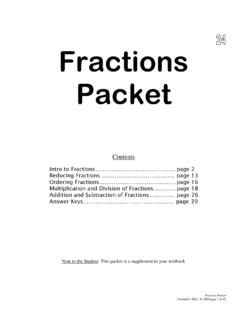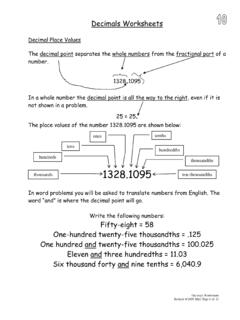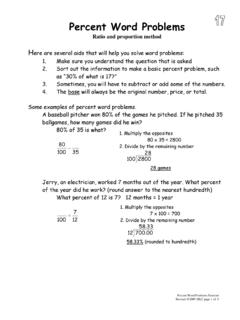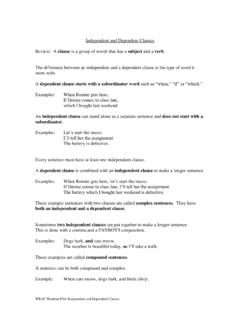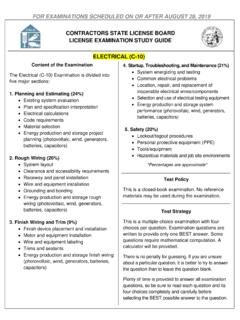Transcription of ACCUPLACER TEST STUDY GUIDE - CNM
1 ACCUPLACER TEST STUDY GUIDE Copyright EmerGents, LLC 2004 All Rights Reserved ENGLISH GRAMMER AND USAGE The following list of English Grammar Rules and their Usage Rules are essential for you to know. You must be familiar with these rules if you want to score well in this area of the test. Capitalization 1. Capitalize the first word of a sentence. 2. Capitalize all proper names. Example: Russia, United Methodist Church, Dan Marino. 3. Capitalize days of the week, months of they year, and holidays. Example: The package was mailed on Tuesday, the day after Easter. Note: Do NOT capitalize seasons.
2 Example: In Hawaii, summer is hot. 4. Capitalize the first and all other important words of a title. Example: The Art of a Blacksmith 5. Capitalize nouns that are not regularly capitalized when they are used as part of proper names. Example: Tomorrow, I am going to visit Aunt Mary, my favorite aunt. Example: Tiger Avenue is a very wide avenue. 6. Capitalize the points of the compass only when referring to a direction. Example: Many people enjoy country food in the South. Note: Do NOT capitalize the points of the compass when referring to direction. Example: Many geese head south in the fall.
3 7. Capitalize languages and specific place names used as modifiers. Do not capitalize any other school subjects. Example: In two years, I will take German, astrology, English literature, geometry, American history, and ancient cultures. 8. Capitalize the first word of a direct quotation. Example: It was Martin Luther King who said, I have a dream. Note: Do NOT capitalize the first word within quotation marks if it does not begin a complete sentence, when a directly quoted sentence is broken. Example: I hit my head, he told us, because the cabinet was left open.
4 Punctuation The Apostrophe 1. Use an apostrophe to indicate possession. Place the apostrophe according to this rule: The apostrophe, when used to indicate possession, means belonging to everything to the left of the apostrophe. Examples: man s = belonging to the man men s = belonging to the men children s = belonging to the children Note: To test for correct placement of the apostrophe, read of the. Example: childrens = of the children (clearly incorrect) The placement rule applies at all times, even with regard to compound nouns separated by hyphens and with regard to entities made up of two or more names.
5 Example: son-in-law s = belonging to a son-in-law Example: Morris, Benson, and Smith s law firm = the law firm belonging to Morris, Benson, and Smith Example: Gomez and Son s delivery truck = the delivery truck of Gomez and Sons 2. Use an apostrophe in a contraction in place of the omitted letter or letters. Examples: haven t = have not we re = we are let s = let us o clock = of the clock class of 85 = class of 1985 Note: Do NOT start a paragraph with a contraction that begins with an apostrophe. 3. Use an apostrophe to form plurals of numbers, letters, and phrases referred to as words.
6 Example: The child pronounced his t s as b s. Example: Solution of the puzzle involves crossing out all the 3 s and 9 s. Example: Her speech was plagued with you know s. The Colon 1. Use a colon after the salutation in a business letter. Example: Dear Committee Member: 2. Use a colon to separate hours from minutes. Example: The sun rose at 6:01 3. Use of the colon is optional in the following cases: (a) to introduce a list, especially after an expression such as follows (b) to introduce a long quotation (c) to introduce a question Example: My question is this: Are you interested in the job?
7 The Comma 1. Use a comma after a salutation of a personal letter. Example: Dear Joe, 2. Use a comma after a complimentary close to a letter. Example: Sincerely, 3. Use a comma or pair of commas to set off a noun of address. Example: When you finish washing your car, Mike, please sweep the porch. 4. Use a pair of commas to set off an appositive, a phrase that follows a noun or pronoun and means the same as that noun or pronoun. Example: Mr. Jones, our designer, did an excellent job. 5. Use a pair of commas to set off parenthetical expressions, words that interrupt the flow of the sentence, such as however, though, for instance, by the way.
8 Example: We could not, however, get her to disagree. Example: The movie, I believe, is the best of its time. Note: Test for placement of commas in a parenthetical expression by reading aloud. If you would pause before and after each such expression, then it should be set off by commas. 6. Use a comma between two or more adjectives that modify a noun equally. Example: The young, nervous, second-grade teacher stood at the front of his class of 34 seven-year-olds. Note: If you can add the word and between the adjectives without changing the sense of the sentence, then use commas. 7. Use a comma to separate words, phrases, or clauses in a series.
9 The use of a comma before and is optional. If the series ends in etc., use a comma before etc. Do not use a comma after etc. in a series, even if the sentence continues. Example: Gloves, umbrellas, and shoes should be placed in the closet down the hall. Example: Rules, pens, notebooks, etc. belong in your office drawer. 8. Use a comma to separate a short direct quotation from the speaker. Example: He said, I want to drive my car today. Example: Tomorrow I am going dancing, she told us. 9. Use a comma after an introductory phrase of five or more words. Example: Because the prisoner had a history of attempted jailbreaks, he was put in an area with maximum security.
10 10. Use a comma after a short introductory phrase whenever the comma would aid clarity. Example: As a child he was playful. (no comma needed) Example: To Paul, Joe was a friend as well as a co-worker. ( comma helps to clarify) Example: In 1934, 400 people lost their lives in a single air disaster. (comma helps to clarify) Note: A comma in not generally used before a subordinate clause that ends a sentence, though in long, unwieldy sentences like this one, use of such comma is optional. 11. Use a comma before a coordinating conjunction unless the two clauses are very short. Example: The man wanted to bail his friend out of jail, but the corrections officer would not allow him to take his friend until he had paid the fine.
